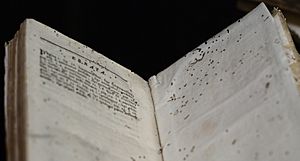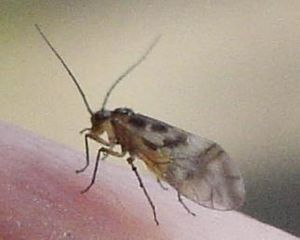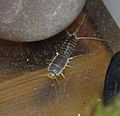Bookworm (insect) facts for kids
A bookworm is a common name for any insect that is thought to chew through books. People often imagine a worm-like creature boring holes in pages. However, this idea is mostly a myth. Most insects that damage books are not worms at all. They are usually tiny beetles, lice, or other bugs.
These insects do not often chew through entire books. Instead, they are usually attracted to certain parts of books. They might eat things like mold or the glue used in bindings. They prefer books that are kept in warm, damp places.
Contents
Meet the Real "Bookworms"
Many different insects can cause damage to books. They are not always "worms" that drill holes. Here are some of the common ones:
Beetles That Chew Wood
Some beetles, like the death watch beetle and the common furniture beetle, usually eat wood. Their young, called larvae, can sometimes chew through paper if it is very close to wood. This is not very common, though.
Tiny Booklice
One of the main insects that damages books is the booklouse. These are very tiny insects, usually less than 1 millimeter long. They are soft-bodied and do not have wings. Booklice are not true lice. They mostly eat mold and other tiny plants that grow on books. This happens when books are not kept clean or in a safe, dry place. Booklice can also damage the book's binding and other parts.
Other Common Pests
Many other insects will also eat mold or old paper. They might also enjoy the starch-based glues used in older books.
- The silverfish (Lepisma saccharina) is a small, shiny insect. It likes to eat paper and glue.
- Cockroaches (various Blattodea species) can also damage books. They eat moldy paper and bindings.
These insects need warmth and moisture to survive. So, book damage is more common in places with high humidity, like tropical areas. Luckily, modern glues and paper are usually less appealing to these insects.
Insects That Attack Bindings
Some insects prefer certain types of book bindings:
- Moths like Tineola bisselliella and Hofmannophila pseudospretella can attack cloth bindings.
- Leather-bound books can attract bugs like the Dermestes lardarius. The larvae of Attagenus unicolor and Stegobium paniceum also like leather.
The "Bookworm Moth" Myth
There is a moth called the bookworm moth (Heliothis zea or H. virescens). But its larvae are not interested in books at all! These larvae are actually pests for farmers. They cause damage to cotton or tobacco plants. They are known as the cotton bollworm or tobacco budworm.
Related pages
- Woodworm
- Books
Images for kids
See also
 In Spanish: Polilla de los libros para niños
In Spanish: Polilla de los libros para niños












